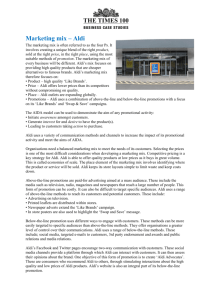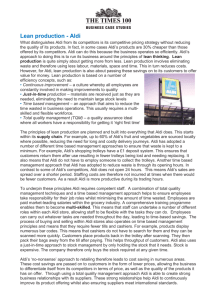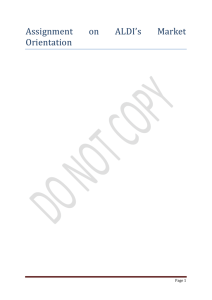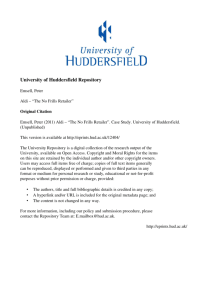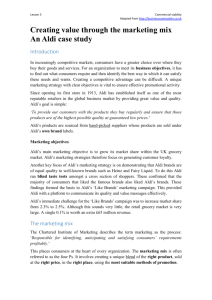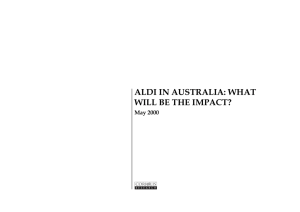strategy for successful entry into a concentrated and highly
advertisement
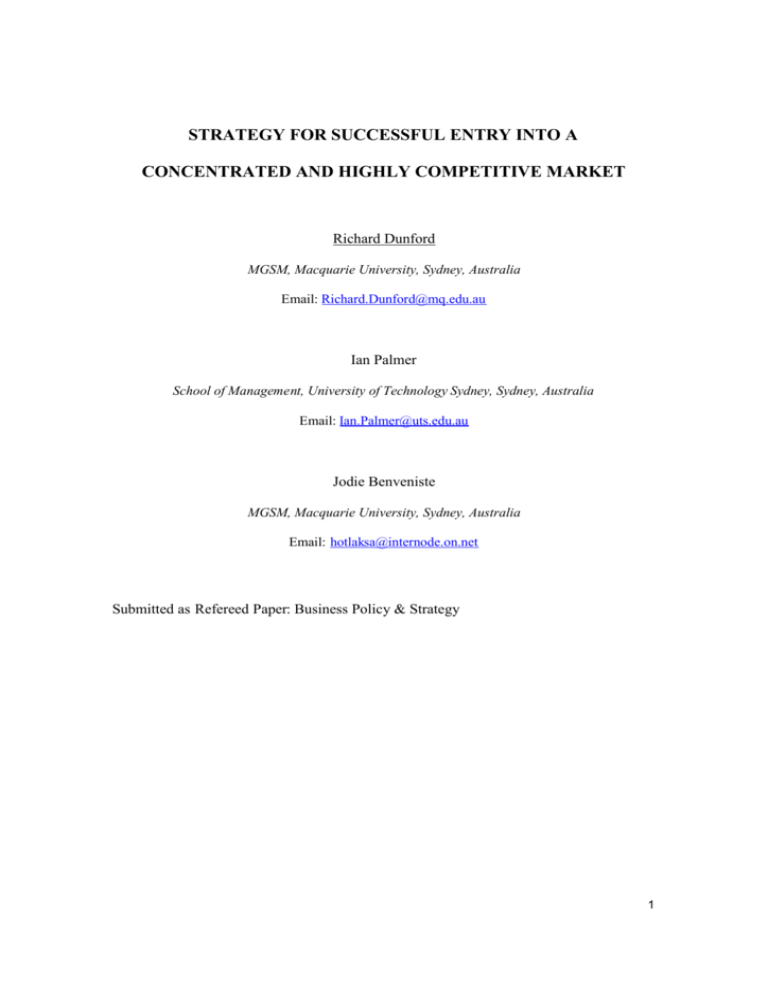
STRATEGY FOR SUCCESSFUL ENTRY INTO A CONCENTRATED AND HIGHLY COMPETITIVE MARKET Richard Dunford MGSM, Macquarie University, Sydney, Australia Email: Richard.Dunford@mq.edu.au Ian Palmer School of Management, University of Technology Sydney, Sydney, Australia Email: Ian.Palmer@uts.edu.au Jodie Benveniste MGSM, Macquarie University, Sydney, Australia Email: hotlaksa@internode.on.net Submitted as Refereed Paper: Business Policy & Strategy 1 STRATEGY FOR SUCCESSFUL ENTRY INTO A CONCENTRATED AND HIGHLY COMPETITIVE MARKET ABSTRACT The Australian grocery sector is both highly concentrated and highly competitive, providing a major challenge to any would-be new entrant. Despite the attractiveness of the Australian market to global players (Zarkada-Fraser & Fraser, 2002), no foreign-owned retailer had established a successful greenfield operation in Australian until this was achieved by ALDI. In this paper, we report the result of research which sought to understand how ALDI has achieved this outcome. The results indicate the centrality of the “coherence” (Roberts, 2004) of key design elements strategy, structure, operations, HR practices and culture – in producing this outcome. KEYWORDS Market entry, competitive advantage, competencies, activity systems, coherence INTRODUCTION The Australian grocery market is the most heavily concentrated in the world. The two leading players, Woolworths and Coles Myer, control 76% of the market. In comparison, the ‘Big 3’ supermarket retailers in the UK account for less than 50% of the market and in the US they account for less than 25% of the market (Schmidt & Lloyd, 2003). Woolworths and Coles Myer have combined sales of $55 billion or 8% of Australia’s economy. Coles Myer is Australia’s biggest employer with 165,000 staff and Woolworths is Australia’s second largest employer with 145,000 staff (Schmidt & Lloyd, 2003). Woolworths operates more than 690 supermarkets under various brands. Coles Myer has two grocery chains – Coles with more than 460 supermarkets and Bi Lo with more than 205 stores (Australian Competition & Consumer Commission, 2004). Despite heavy concentration within the industry, there is intense rivalry among existing competitors. The intensity of competition is such that average supermarket margins in Australia are estimated at 4.4%, compared with 7.4% in the United States and 7.2% in Britain (James, 2 2003). Woolworths and Coles are also expanding their retail coverage to include petrol, liquor, pharmaceuticals and fresh flowers in an effort to boost sales and profitability (Samuel, 2003). Into this concentrated and competitive environment, in 2001, came the international grocery retailer ALDI. This was an interesting move given that entry into the Australian market is complex and difficult (Zarkada-Fraser & Fraser, 2002) with no foreign-retailer having previously been able to establish a presence from scratch in Australia. However, by 2004 ALDI had 83 stores across four states and had secured 4% of the NSW grocery market (AC Nielsen, 2004). It is a billion dollar business with paid up capital of $1.25 billion (Mitchell, 2004), turnover of between $500 million and $1 billion with 200 stores are expected across Australia by 2006 (Jimenez, 2004). The focus of the research reported in this paper was to explain ALDI’s successful entry into this highly concentrated and competitive market where previous would-be entrants had failed. BUNDLED COMPETENCIES, CONFIGURATION, ACTIVITY SYSTEMS AND COHERENCE Within strategic management there are a diverse range of concepts have in common the focus on the importance of the interactive effect of a range of key organization design variables on performance. That is, the success of a strategic initiative does not depend on any one element in isolation. Within the resource-based theory of the firm (Grant, 1991; Peteraf & Barney, 2003), it is recognized that competitive advantage may require the ‘bundling’ of organisational capabilities (Barney, 1996). Similarly, within the configuration view of strategy (Miller, 1996; Miller, Eisenstat & Foote, 2002) competitive advantage is derived from the mutually reinforcing affect of consistency between key organizational variables. Porter (1996: 73) argues that a firm’s unique system of activities is its source of sustained competitive advantage because an “array of 3 interlocked activities” is more difficult to imitate than a single activity. Most recently, Roberts (2004) has argued that the mutual reinforcement (“coherence”) of “complementary” organizational design elements is central to strategic success. In this paper, we describe ALDI Australia’s key design characteristics and discuss how their interactive effect may explain its performance. METHOD Data collection Data came from two sources, semi-structured interviews and archival material (company documents, media reports, etc). We conducted 22 interviews of 30 to 90 minutes duration. At least two members from the research team were present at the majority of interviews. Interview selection was based on the concept of ‘horizontal and vertical slices’ (Dunford & Palmer, 2002). The horizontal slice involves interviewing people across the various functions/businesses in an organization. In this study, the 11 members of top management comprised the horizontal slice. The vertical slice comprised 11 interviews with staff from various levels within the organization. Random sampling was used to identify interviewees. Data analysis Interviews were semi-structured and based on questions which asked interviewees about the strategy of ALDI Australia and its processes. Interviews were recorded and transcribed, then interview notes were analysed using NVivo. Two of the researchers independently analysed the interview notes to identify themes and to code data. The research team then agreed upon themes and sub-themes and categorized the text accordingly. Data from annual reports, internal documents, business media and online sources were also analysed. 4 THE BASIS OF ALDI AUSTRALIA’S COMPETITIVE POSITION Strategy ALDI’s strategy focuses on providing high quality products at low prices. Key elements of the low price element of the strategy are: (1) exclusive brand products, (2) limited range, (3) focus and (4) price change policy. Exclusive brand products Central to ALDI’s strategy is its focus on exclusive brand products. ALDI forms partnerships with leading manufacturers to produce own-brand goods. Only a few name brand products, such as Vegemite, are offered and even these are targeted for replacement when a low cost, high quality alternative can be sourced. Limited range Central to ALDI’s capacity to reduce costs is the provision of only a limited range of products. In regard to what to stock in terms of product characteristics, ALDI take their lead from the market: “We follow the market regarding what is successful, like size, variation. We’re not here to change what people want.” (TMT05). ALDI then seek suppliers who can provide the product with the required characteristics (e.g., taste) at the most competitive price. Products are made available in their most popular size, not in all sizes. As a result, unlike traditional supermarkets which stock up to 20,000 lines, ALDI stocks only 600 to 700 lines. By stocking only one size of each product ALDI significantly reduces costs. We sell one orange juice compared to 43 in Coles. We have fewer products and sell in very large quantities. We go for the best-selling size. If 1 kg is best we don't care about 2 kg. (TMT07) Focus ALDI’s strategy involves a strict focus on what it sees as core business. Thus they are not following the Woolworths and Coles practice of expanding their retail base to include petrol, pharmaceuticals, liquor and online shopping. 5 We don’t like to jump on the bandwagon. It needs to fit our system. Like online shopping. I can’t see how it would work for us. We don’t add to our list because it looks good.(TMT09) The one area where ALDI will deviate from a very strict policy of selling only core products is that it has a practice of “surprise buys”, in which a batch of products like televisions or computers will be sold in the stores for a fixed period. These “surprise buys” are especially prepared for, and bought in bulk by, ALDI to conform with the low price/high quality policy. Price change policy ALDI policy on price changes is to be the first in the industry to pass on lower costs to customers and the last to increase prices when costs increase. They point out the change to customers through placing a note on cartons in the stores. Key elements of the quality element of the strategy are: (1) the value proposition and (2) a longterm approach. The value proposition A critical element of the ALDI “value proposition” is that it will not be low cost “at any cost” in that a certain level of quality must be maintained, even if at the expense of a higher retail price. We do not sell low quality. Sometimes, this may mean higher prices, but with superior quality. For example, we sold mince with a 5% fat content where our competitors were selling it with 20% fat content. We did not want low quality. We just don’t do it’ (TMT07) A long-term approach As a privately-owned organization ALDI has an enhanced capacity to make business decisions that may impact negatively on short-term returns but which make long-term sense. For example, stores are built to last 20 to 25 years with minimal maintenance. They are more costly to build but cost savings occur over the life of the building. ALDI also develops longterm partnerships with suppliers. If a would-be supplier provides a cheaper quote for the 6 required quality of product, ALDI gives their existing suppliers preference if they can compete on price. Structure ALDI’s structure has three key characteristics: (1) flexibility built around formalization of key elements (2) decentralisation (3) minimization of functions. Flexibility built around formalization of key elements Clear reporting lines allow for quick information flow and consensus decision-making. To avoid misunderstanding and increase efficiencies, rules and expectations are specified in the ALDI Management System, occupational health and safety manuals, training manuals and job descriptions. High formalization in these areas sends clear messages to staff in regard to what they can and cannot do, with even extreme situations covered. Staff reported the formalization as enabling rather than constraining, because they provide clarity as to the context within which discretion may be applied. We like to formalise the skeleton to make the business safe and structured. Job descriptions determine what people can and can’t do. Knowledge and experience let you know how to act. (TMT09) Decentralization Warehouses only support 60 to 70 stores. Once the capacity is reached, a new region is created and the roles replicated. Store sizes are also capped. An ALDI store has 10 to 15 employees with four to six cash registers. Rather than make an existing store bigger, ALDI will open more stores in an area. Decentralisation also extends to performance monitoring. While regional management monitor the sales, inventory and productivity of individual stores, financial viability is not monitored on a per store basis. This is done in the interests of efficiency. ‘We don’t micro-manage each store’s performance. We have a balance sheet for the region but not for each store. You’d need to employ another person to tackle that and we’d rather save the costs.’ (TMT02) 7 Minimization of functions ALDI’s focus on core business and cost minimization also takes the form of it not having marketing, public relations, human resource, information technology or legal departments. We are lean. We focus on what is necessary, on efficiency and being prudent. We question whether things are really needed. (TMT09) The lack of marketing and PR functions is also not accompanied by significant outsourcing except for advertising. This is because ALDI prefers to rely on word-of-mouth and localized advertising. This has sometimes been interpreted as secretiveness by ALDI but from their perspective it is simply that they don’t seek public accolades and would rather spend their time and energy on activities which they believe increase their capacity to compete on quality and price. Also, in this regard, as a private company, they do not need to impress the investor market. There is no marketing department at ALDI. We don’t engage in lots of PR. We’d rather just go out and look for more sites.(TMT01) Operations / Logistics ALDI is a global business model that has been applied in Australia with minimal variation. Efficiency ALDI streamlines processes in order to gain efficiencies and save on costs. Goods are handled as little as possible – once into the warehouse and once out to the store. A focus on efficiency means an uncluttered warehouse. The warehouse looks empty but it’s not double or triple stacked. We use space differently. It’s not used to its full capacity but this enables quick transfers. No time is wasted and produce is fresh for customers. (TMT09) Suppliers also contribute to efficient processes by manufacturing in open cartons and supplying the product on pallets. By getting suppliers to do more of the work, ALDI just wheels the products into the store. In store, simple display methods are used to enhance ease of shopping and to increase efficiencies in stock handling. The same layout is used in all stores and the store 8 layout corresponds to the layout of the warehouse to save time and money. Products are located in the same order in each store. Staff levels are much lower than in traditional stores. Low technology ALDI is a low technology operation. Unlike traditional supermarkets, ALDI is a low technology operation with largely manual processes. As ALDI stocks fewer product lines, a sophisticated IT ordering system is seen as unnecessary and as something that would add complexity and, most significantly, cost. Instead, store managers walk around the store with a handheld computer and order stock in layers of product based on their knowledge of stock turnover. Compared to the $100 million investment by Woolworth's in sophisticated IT systems we believe that the store manager’s brain is the most efficient technology system. (TMT07) People management practices The ALDI Management System ALDI is very specific in terms of the people management practices that it requires of its managers. This is formalized in “The ALDI Management System” which has four key principles: (1) delegation of responsibility, (2) no management interference, (3) the “grandfather principle” and (4) feedback behind closed doors. Firstly, managers at ALDI are not only encouraged to delegate but, as leaders, they are expected to do so. Staff are told what needs to be achieved, rather than how to achieve it. Secondly, managers are allowed to manage without interference so that they have some of the sense of being self-employed while also being supported by a large organisation. Thirdly, the ‘grandfather principle’ states that hiring and firing decisions are made by the manager above a person’s immediate manager. Fourthly, feedback is provided behind closed doors. Neither praise nor criticism occurs publicly, only privately. Recruitment Industry experience is not a key factor in the selection of new staff. In fact, a retail background can be a drawback as it may be seen as having embedded in the individual a quite different 9 perspective on retailing than the one ALDI wishes to inculcate. Therefore, ALDI seeks to recruit individuals which it sees as the best fit with the ALDI approach to business. Often this is characterized as having a capacity to show initiative. Training ALDI invests substantially in training. Having found those they believe to be right for the organization, they train them and aim to keep them. ALDI wants long term relationships with staff in order to maximize the benefit from the training investment and their fit with the ALDI culture. Area Managers may receive a combination of local and overseas training, the specific mix depending on each individual’s needs and training requirements. Also, an international exchange and development program is in place for Area Managers deemed to be “high potential.” Unlike other supermarket operations, staff are trained to be multi-skilled in order that the stores can gain from associated efficiencies. For example, staff do not remain at the checkout if there are no customers. Instead, they go back onto the floor to replenish stock, pack and clean. This also seems to have some motivational benefits in the form of increased commitment and pride in the effective running of the store. Pay and reward All staff are paid well-above award wages and are aware that they cannot match their salary elsewhere in the industry. Store staff also receive a monthly productivity bonus based on store performance. Management are not included in the bonus system, but they do receive higher than industry average salaries (They’re golden handcuffs...I’m here for life.” TMT06). The combination of a high base salary and no bonuses for short-term results is designed to reinforce the need for a long term focus. The philosophy is that management do the right thing rather than push people to increase productivity for their personal gain and in the process burnout people in the stores. We want everybody in management to do the right thing so for their base salary they are paid far above the industry-standard, some 22-25%. A decent salary is taken for granted. (TMT07) 10 Culture Inside ALDI reference is made to “The ALDI Way” a characterization of the expected values and behaviours of ALDI employees. The elements are (1) working hard, (2) being professional, (3) acting ethically, (4) being fair and showing respect, (5) being efficient, (6) taking a team approach and (7) showing initiative. The interviews indicated a high level of consistency between this espoused culture that the “lived reality” described by the employees. The culture manifests itself in some interesting ways, from small acts symbolizing the focus on costs – “We walk out of the room and we turn the light off” (TMT04), through to acts consistent with ALDI’s emphasis on keeping technology simple. No email - and rarely phone - occurs within the Australian head office, instead face-to-face conversations occur. Personal contact with other staff is the way we do business. Some days I wear my legs out, walking up and down the stairs talking to my colleagues. Picking up the phone is not our way of doing business. (TMT10) Conclusion The Australian supermarket sector is highly concentrated and competitive. Despite this situation, and the poor track-record of previous would-be entrants, ALDI has been able to quickly establish a significant and growing presence. No one feature of ALDI’s approach has been responsible for its success rather it has been a result of a mutually reinforcing array of activities, i.e., “coherence” (Roberts, 2004). This situation is represented in the activity system (Porter, 1996) portrayed in Figure 1. ALDI’s strategy to provide high quality, low cost products drives its focus on exclusive brand products, on eliminating unnecessary business functions and on building stores and relationships with staff and employees for the long-term. ALDI’s structure, centred around clear reporting lines and self-sufficient regions, and its low-tech operations, are designed for efficiency. 11 ALDI’s people management practices, including its selection policies, paying above award wages, multi-skilling and delegation of responsibility are aimed at developing a committed, efficient, workforce. Having created a systemic set of activities to support its strategic position has enabled ALDI to carve out a niche in a highly competitive market. -------------------------Figure 1 About Here -------------------------FIGURE 1: ALDI’s Activity System Simple display methods in store Exclusive brand products Limited range Uncluttered warehouse Low tech High quality, low cost products Efficiency Minimum staff Surprise buys No marketing Partners with suppliers Multiskilling Clear reporting lines The ALDI way Stores that last Committed workforce Long term approach Above award wages Jobs for life Delegate Privately owned Recruit the best 12 References AC Nielsen (2004) ‘AC Nielsen Shopper Trends’, June 16, www.acnielsen.com.au Australian Competition & Consumer Commission (2004) ‘Assessing Shopper Docket Petrol Discounts and Acquisitions in the petrol and grocery sectors’, www.accc.gov.au Barney, J (1996) Gaining and Sustaining Competitive Advantage, Reading: Addison-Wesley. Dunford, R & Palmer, I (2002) ‘Managing for high performance? People management practices in Flight Centre’, Journal of Industrial Relations, vol. 44, no. 3, pp. 376-396. Grant, RM (1991) ‘The resource-based theory of competitive advantage: Implications for strategy formulation’, California Management Review, vol. 33, no. 3, pp. 114-135. James, D (2003) ‘Retailers Take The Next Step’, Business Review Weekly, November 13. Jimenez, K (2004) ‘ALDI Hits State with Price War Promise', The Australian, June 23. Miller, D (1996) ‘Configurations Revisited’, Strategic Management Journal, vol. 17, no. 7, pp. 505-512. Miller, D, Eisenstat, R & Foote, N (2002) ‘Strategy from the Inside Out: Building Capabilitycreating Organizations', California Management Review, vol. 44, no. 3, pp. 37-54. Mitchell, S (2004) ‘Aldi Tops $1bn Mark', Australian Financial Review, June 25. Peteraf, M & Barney, J (2003) ‘Unravelling the Resource-based Tangle', Managerial and Decision Economics, vol. 24, pp. 309-323. Porter, ME (1996) ‘What is Strategy’, Harvard Business Review, vol. 74, no. 6, pp. 61-78. Roberts, J (2004) The Modern Firm: organizational design for performance and growth, New York: Oxford University Press. Samuel, G (2003) ‘Imperfect Balance’, Business Review Weekly, November 13. Schmidt, L & Lloyd, S (2003) ‘Monster Of Retail’, Business Review Weekly, November 13. Zarkada-Fraser, A & Fraser, C (2002) ‘Store Patronage Prediction for Foreign-owned Supermarkets’, International Journal of Retail & Distribution Management, vol. 30, no. 6/7, pp. 282-299. 13
